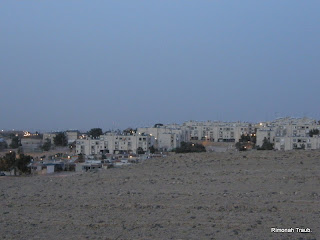A most fascinating and unique geological
phenomenon is found in Machtesh Ramon, in the Negev
(see last week’s column for more information on this area).
To someone who has been in a carpentry shop or sawmill, it might seem that spread
over the desert sand are pieces of castoff ends of sawed lumber, just like
those in a sawmill.
Looking up the low hill that stands above the piles are a number of what appear to be standing logs of wood from which the chips on the ground seem to have been cut. But if you were to bend downand lift an elongated, darkened piece of the “wood,” you would find it very heavy indeed. In reality, you would be holding a piece of sandstone. On top of the hill, there are blocks of exposed sandstone shaped like symmetrical, hexagonal pillars placed in a heap, just like wooden planks in a carpenter’s shop.
The thousands of strewn “woodchips” are actually black prismatic rocks made out of the same kind of sand found on beaches. Haminsara (The Carpentry Shop/Sawmill) is one of the rare places on earth these naturally formed, rectangular and hexagonal prisms of “toasted” stones can be found, and where such a geological sight exists. (A similar phenomenon can be seen in the Meshushim [Hexagons Pool], in the
It is claimed that these almost-identical
stones were created during a volcanic eruption, when volcanic emission
penetrated into a sandstone hill and melted (liquefied) the sandstone. The
liquid stone then consolidated and crystallized into these long quartzite forms
(quartzite is a hard metamorphic rock which originates from sandstone and is
created by heat and pressure).
It seems the former sandstone hill was “baked” by heat from inside the earth’s crust, which caused the sandstone to crystallize (high-temperature
metamorphosis) and take on the appearance of prisms, or alternatively,
woodchips. They received the dark colouring from the iron mineral deposits (manganese
and cobalt) in them that corroded when they came in contact with the air.
The incredible vistas of Machtesh Ramon can
be viewed from lookout points in Mitzpeh Ramon. From here the Sawmill (Haminsara) is seen as
a black spot in the crater.
There is easy access to the “sawmill” site that is on the south side of Highway 40
(from Mitzpeh-Ramon to Eilat), between kilometer markers 92
and 91. After a short drive on the dirt-road, park the car and start the short
ring-trail that leads on top of special lifted plates that allow walkers to
tread above the quartzite prisms without damaging
them.
Walk on, and follow, the
platform boardwalk. This boardwalk was constructed to facilitate easy access to
the top of the hill. In fact, it has a slight incline and is set up to be
convenient even for individuals with mobility problems. It is made of recycled industrial
plastic — compressed plastic bottles — in keeping with
environmental principles. The trail is what is termed a
recycling project.
The flora in the machtesh and around the minsara is typical of the warm
desert areas of the Negev . Of all of Israel Ramon Ridge
The vastly different
weather conditions of the area during various seasons (freezing cold winters and very hot, dry summers)
also plays a large role in this. For instance, the bitter winter cold sometimes
delays the main flowering season to late winter and spring, when the flowers
will bloom with astonishing beauty. Lovely flowers in bloom, such as tulip (tsivoni), Jacob’s rod (clumps of
bluish-green, grass-like foliage bearing dense spikes of pale yellow, star-shaped
flowers), and anemone (kalaniyot) are found
in the spring.
The tulip derives its name
from the word “thuliban,” “turban” in Persian, which it is
thought to resemble. When in bloom, its vivid, deep scarlet-red colour blankets
the desert’s rocky floor and can be
seen from miles away. Holland and the beauty of
English royal and cottage garden. This celebrity in many international flower
shows, whose each bulb fetched huge sums in the Tulipmania era (=/- 1620 - 1642 [In 1623 some sold for 1000Florins])
and for whom men mortgaged their homes and estates, was not known in the
western world before the mid/ late 16th century. No western painting, pottery or textile bears
its image before this time.
In 1554 Sultan Suleiman the
Magnificent (the builder of the wall of Jerusalem ’s Old City Vienna Holland
Desert shrubs, including
gymnocarpus and anabasis articulate (yepukar hamidbar), are the vegetation most commonly seen on the
basalt stone, as well as on the limestone and sandstone in the machtesh. The gymnocarpus sheds its
leaves to conserve water during the hot weather; the anabasis can regulate its
water use by drying out its green bark.
Wildlife in the region
includes ibex, leopards, wolves, foxes, mice and various reptiles, while
vultures nest on cliffs of the machtesh. The coroneted sand grouse, a diurnal bird, is
adapted to desert living. It requires water to drink, and to quench the thirst
of the fledglings, the adult males wet their neck feathers and thus fly water
to their nests.



No comments:
Post a Comment